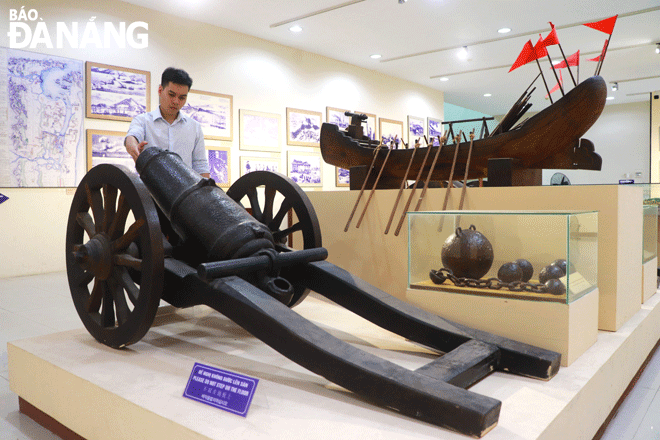Cannons in Dien Hai Citadel - warriors and historical witnesses
2023 marks the 165th anniversary of Da Nang’s first fight against French-Spanish coalition forces in 1858.
In the battle, cannons in the Dien Hai Citadel, together with the sea gate defence system, played an important role in the victory of the army and people of Da Nang, forcing the French colonialists to withdraw into the Gia Dinh area.
 |
| A cannon is on display at the Museum of Da Nang |
According to documents stored at the Da Nang Museum, in the face of the threat of foreign invasion from the West, the Nguyen Dynasty paid special attention to building a defence system by strengthening weapons and coastal guard stations.
In Da Nang, in 1813, the 12th Gia Long King built two guard stations called Dien Hai and An Hai (currently know in the An Don area, Son Tra District). At that time, the Dien Hai Citadel, also known as station, was built with sand and was located near the mouth of the Han River.
The station was removed to the present position in the 4th year of reign Minh Mang (1823), and had its name changed to a citadel and built solidly with bricks in the 15th year of reign Minh Mang (1834).
In 1847, the citadel was expanded with a height of more than 5m, and a circumference of 556m, and it was surrounded by 3m-deep moats.
During the independent period of the Nguyen Dynasty, the Da Nang estuary was identified as the country’s only diplomatic and foreign one. Therefore, many bastions, guard stations and gates were built along the coast, including the Dien Hai Citadel. At that time, the Dien Hai Citadel was considered as an outpost, gateway, and solid fortification to control the entire coastal area of Da Nang.
Director of the Da Nang Museum Huynh Dinh Quoc Thien said that in order to strengthen the military capabilities of the Dien Hai Citadel, 30 solid brick bastions were constructed, and 30 large cannons, ammunition depots and an elite garrison force were arranged in the citadel.
The Dien Hai Citadel was equipped with 30 large cannons, but the total number of guns of all classes was up to 107. All of these cannons were pointed to the sea, ready to fight the invading foreign ships.
Currently, there are still 13 cannons on display in the campus and exhibition space of the Da Nang Museum. Two of them were brought back from riverside and coastal forts, and the remaining 11 were found in and around the citadel.
“These cannons were directly involved in the early anti-French resistance war. Therefore, it can be said that the cannons in Dien Hai citadel are special witnesses to a heroic historical period of the army and people of Da Nang" Mr. Thien noted.
When found underground, most of the cannons in the Dien Hai Citadel were rusted, and had their rotating shafts broken, but the bodies of the cannons were still mostly intact. Most of them weigh over 1 ton, and the bodies were made from iron, cast iron and brozen.
According to Chairman of the Da Nang Science and History Association Bui Van Tieng, the cannons founded in the Dien Hai Citadel are artifacts of special significance, directly related to the anti-French resistance war in Da Nang in 1858. They are relics associated with the special national-level relic of Dien Hai Citadel. This was the most important weapon showing the strength of the Nguyen Dynasty army at that time.
Under the ingenious direction of the famous general Nguyen Tri Phuong and the support of cannons, for more than 18 months (from September 1, 1858 to March 23, 1860), Da Nang troops and people repelled dozens of attacks of the French-Spanish coalition, forcing them to retreat and entrench in the Son Tra Peninsula for many months, then redirecting their attack to Hue and Gia Dinh fronts.
According to Mr. Huynh Dinh Quoc Thien, under the project on repairing, restoring and embellishing the special national-level relic of Dien Hai Citadel at phase 2, the city will build a cannon house to preserve, display and introduce the weapon system associated with the era when the army and people of Da Nang fought against the French-Spanish coalition.
In the future, after completing the renovation, restoration and embellishment of the Dien Hai citadel at phase 2, the local cultural sector will request the Ministry of Culture, Sports and Tourism to ask for the Prime Minister’s recognition of the cannons in Dien Hai Citadel as national treasures.
Reporting by THIEN DUYEN - Translating by M.DUNG